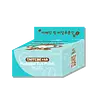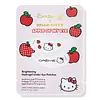What's inside
What's inside
 Key Ingredients
Key Ingredients

 Benefits
Benefits

 Concerns
Concerns

 Ingredients Side-by-side
Ingredients Side-by-side

Water
Skin ConditioningGlycerin
HumectantDipropylene Glycol
HumectantCeratonia Siliqua Gum
Emollient1,2-Hexanediol
Skin ConditioningChondrus Crispus Powder
AbrasiveChondrus Crispus Extract
Skin ConditioningBetaine
HumectantCellulose Gum
Emulsion StabilisingAlgin
MaskingButylene Glycol
HumectantPaeonia Suffruticosa Root Extract
Skin ProtectingCentella Asiatica Extract
CleansingPotassium Chloride
Sodium Polyacrylate
AbsorbentHydrogenated Polydecene
EmollientChamomilla Recutita Flower Extract
MaskingPanthenol
Skin ConditioningGlyceryl Caprylate
EmollientSucrose
HumectantPolyglyceryl-10 Laurate
Skin ConditioningPolyglyceryl-10 Myristate
Skin ConditioningEthylhexylglycerin
Skin ConditioningDextrin
AbsorbentCaffeine
Skin ConditioningTrideceth-6
EmulsifyingHydrolyzed Hyaluronic Acid
HumectantPantolactone
HumectantDisodium EDTA
Parfum
MaskingCI 42090
Cosmetic ColorantWater, Glycerin, Dipropylene Glycol, Ceratonia Siliqua Gum, 1,2-Hexanediol, Chondrus Crispus Powder, Chondrus Crispus Extract, Betaine, Cellulose Gum, Algin, Butylene Glycol, Paeonia Suffruticosa Root Extract, Centella Asiatica Extract, Potassium Chloride, Sodium Polyacrylate, Hydrogenated Polydecene, Chamomilla Recutita Flower Extract, Panthenol, Glyceryl Caprylate, Sucrose, Polyglyceryl-10 Laurate, Polyglyceryl-10 Myristate, Ethylhexylglycerin, Dextrin, Caffeine, Trideceth-6, Hydrolyzed Hyaluronic Acid, Pantolactone, Disodium EDTA, Parfum, CI 42090
Water
Skin ConditioningGlycerin
HumectantMethylpropanediol
Solvent1,2-Hexanediol
Skin ConditioningSimmondsia Chinensis Seed Oil
EmollientCeratonia Siliqua Gum
EmollientChondrus Crispus Extract
Skin ConditioningPolysorbate 20
EmulsifyingCellulose Gum
Emulsion StabilisingPEG-60 Hydrogenated Castor Oil
EmulsifyingPyrus Malus Fruit Extract
Skin ConditioningTremella Fuciformis Extract
HumectantTamarindus Indica Seed Gum
Emulsion StabilisingPotassium Chloride
Xanthan Gum
EmulsifyingCalcium Disodium EDTA
Dextrin
AbsorbentSodium Hydroxide
BufferingSodium Hyaluronate
HumectantAscorbic Acid
AntioxidantParfum
MaskingWater, Glycerin, Methylpropanediol, 1,2-Hexanediol, Simmondsia Chinensis Seed Oil, Ceratonia Siliqua Gum, Chondrus Crispus Extract, Polysorbate 20, Cellulose Gum, PEG-60 Hydrogenated Castor Oil, Pyrus Malus Fruit Extract, Tremella Fuciformis Extract, Tamarindus Indica Seed Gum, Potassium Chloride, Xanthan Gum, Calcium Disodium EDTA, Dextrin, Sodium Hydroxide, Sodium Hyaluronate, Ascorbic Acid, Parfum
Ingredients Explained
These ingredients are found in both products.
Ingredients higher up in an ingredient list are typically present in a larger amount.
1,2-Hexanediol is a synthetic liquid and another multi-functional powerhouse.
It is a:
- Humectant, drawing moisture into the skin
- Emollient, helping to soften skin
- Solvent, dispersing and stabilizing formulas
- Preservative booster, enhancing the antimicrobial activity of other preservatives
Cellulose Gum is a water-soluble polymer that comes from cellulose. It is used to change the texture of a product and to help stabilize emulsions.
As an emulsifier, cellulose gum specifically thicken the texture of water-based products.
This ingredient is considered hypoallergenic and non-toxic. Cellulose Gum can be found in cosmetics, food, and other household goods such as paper products.
Learn more about Cellulose GumCeratonia Siliqua Gum is extracted from the seeds of the carob tree. You might know this ingredient as Carob Gum or Locust Bean Gum. It is used to stabilize other ingredients and improve the texture of products.
Carob gum is made up of long-chain polysaccharides. This makes it a natural thickener.
Yes! This ingredient comes from the seeds of a tree. The name 'Locust Bean Gum' can be misleading.
Learn more about Ceratonia Siliqua GumChondrus Crispus Extract comes from a red algae native to the northern Atlantic coasts of Europe and North America. It helps hydrate the skin and is rich in antioxidants.
The antioxidants in chondrus crispus include lutein and zeaxanthin. Lutein has the ability to filter blue light from screens.
Other contents of chondrus crispus include polysaccharides, peptides, and amino acids. These help hydrate the skin.
What's the difference between algae and seaweed?
Algae is a broad term that includes seaweed. Not all algae is seaweed.
Dextrin is used to thicken a product and helps bind ingredients together. It is created from starch and glycogen.
As an emulsifier, dextrin prevents ingredients from separating. This helps elongate a product's shelf life.
Studies show coating UV filters with dextrin prevents these ingredients from being absorbed. This helps UV ingredients last longer on the skin.
Learn more about DextrinGlycerin is already naturally found in your skin. It helps moisturize and protect your skin.
A study from 2016 found glycerin to be more effective as a humectant than AHAs and hyaluronic acid.
As a humectant, it helps the skin stay hydrated by pulling moisture to your skin. The low molecular weight of glycerin allows it to pull moisture into the deeper layers of your skin.
Hydrated skin improves your skin barrier; Your skin barrier helps protect against irritants and bacteria.
Glycerin has also been found to have antimicrobial and antiviral properties. Due to these properties, glycerin is often used in wound and burn treatments.
In cosmetics, glycerin is usually derived from plants such as soybean or palm. However, it can also be sourced from animals, such as tallow or animal fat.
This ingredient is organic, colorless, odorless, and non-toxic.
Glycerin is the name for this ingredient in American English. British English uses Glycerol/Glycerine.
Learn more about GlycerinParfum is a catch-all term for an ingredient or more that is used to give a scent to products.
Also called "fragrance", this ingredient can be a blend of hundreds of chemicals or plant oils. This means every product with "fragrance" or "parfum" in the ingredients list is a different mixture.
For instance, Habanolide is a proprietary trade name for a specific aroma chemical. When used as a fragrance ingredient in cosmetics, most aroma chemicals fall under the broad labeling category of “FRAGRANCE” or “PARFUM” according to EU and US regulations.
The term 'parfum' or 'fragrance' is not regulated in many countries. In many cases, it is up to the brand to define this term.
For instance, many brands choose to label themselves as "fragrance-free" because they are not using synthetic fragrances. However, their products may still contain ingredients such as essential oils that are considered a fragrance by INCI standards.
One example is Calendula flower extract. Calendula is an essential oil that still imparts a scent or 'fragrance'.
Depending on the blend, the ingredients in the mixture can cause allergies and sensitivities on the skin. Some ingredients that are known EU allergens include linalool and citronellol.
Parfum can also be used to mask or cover an unpleasant scent.
The bottom line is: not all fragrances/parfum/ingredients are created equally. If you are worried about fragrances, we recommend taking a closer look at an ingredient. And of course, we always recommend speaking with a professional.
Learn more about ParfumPotassium Chloride can be bad for oily skin and be bad for acne prone skin.
Water. It's the most common cosmetic ingredient of all. You'll usually see it at the top of ingredient lists, meaning that it makes up the largest part of the product.
So why is it so popular? Water most often acts as a solvent - this means that it helps dissolve other ingredients into the formulation.
You'll also recognize water as that liquid we all need to stay alive. If you see this, drink a glass of water. Stay hydrated!
Learn more about Water